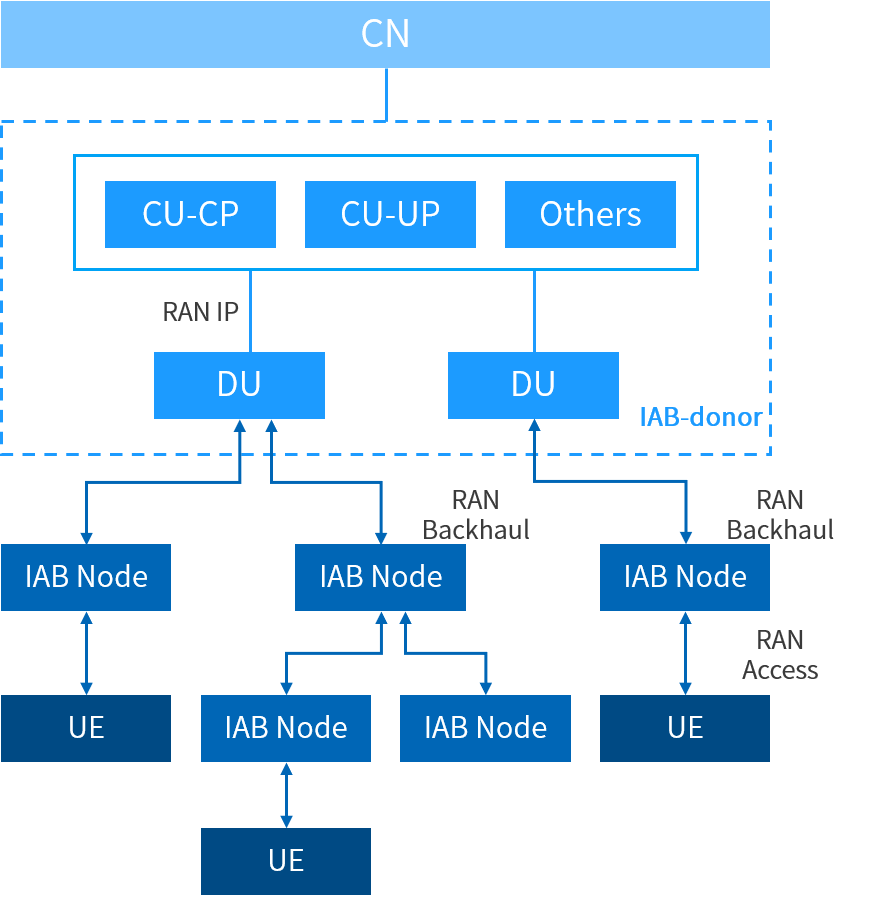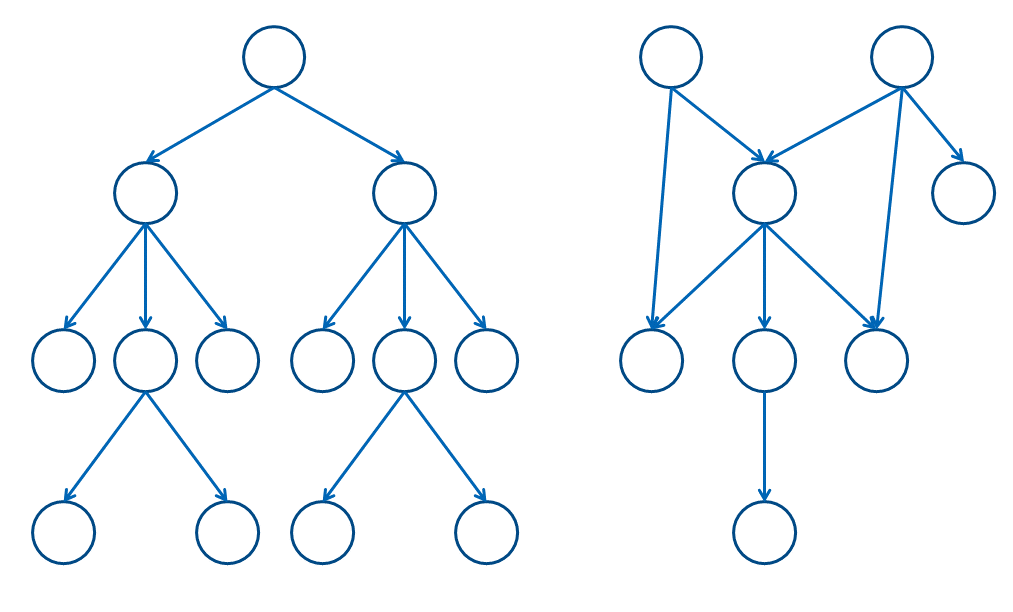IAB Principles and Application
-
Introduction
With the significant growth in demand for 5G communication and the increasing diversity of application scenarios, operators and private network markets are deploying various types of base stations to achieve network coverage. However, some of the frequency bands used by 5G are relatively high, with shorter wavelengths and greater penetration losses, resulting in a smaller coverage area. Therefore, for some dense network deployments, complex terrain scenarios, and remote areas, it is obviously too expensive or impractical to deploy fiber to all base stations. This requires a more flexible and cost-effective technology to reduce the dependence of 5G base stations on wired transmission networks. In R16, the protocol introduced IAB (Integrated Access Backhaul) to address this issue.
To better meet diverse coverage scenarios, SageRAN continues to research various new networking solutions and layout communication frontier technologies such as IAB.
-
IAB Technology Defined in R16
IAB is to integrate access and backhaul to save fiber resources for backhaul and effectively reduce the deployment cost of backhaul networks. IAB was initially introduced in the 10th edition of 3GPP in 2011 but was not adopted by LTE due to practical issues with low eNodeB density. Due to the inherent limitations of coverage in the mid-frequency and above frequency bands of 5G NR, the standardization work of IAB officially started in the R16 stage and completed the first phase of standardization work in 2020. The main feature of IAB is to achieve flexible and dense small cell deployment through wireless backhaul and multi-hop relay, providing flexible coverage expansion and reducing the dependence on wired transmission networks.
(1) Technical Features
The nodes in IAB are divided into two types: IAB-donor and IAB-node. IAB-donor is the terminating node of IAB on the network side, which uses wired fiber for backhaul, while IAB-node is a base station node with wireless backhaul function, deployed in areas where network coverage is expected to be extended, and does not require fiber for backhaul.

Figure 1: IAB network diagram
IAB-node consists of two modules, one called IAB-DU, which is equivalent to the gNB DU function and can serve ordinary UE and IAB sub-nodes, and the other called IAB-MT, which supports some UE physical layer, AS layer, and NAS layer functions and is connected to the IAB parent node through a wireless air interface.

Figure 2: IAB node relationship diagram
R16 IAB only supports fixed IAB node deployment and does not consider scenarios where IAB nodes move. However, fixed IAB nodes can select a more suitable parent node for access or switching based on the signal quality of the wireless backhaul link with the parent node, achieving adaptive adjustment of the network topology. The topology structure of IAB only supports extended trees and directed acyclic networks.

Figure 3: Extended tree and directed acyclic network
IAB can support both standalone network (SA) and non-standalone network (NSA) connection architectures. In particular, if NR-DC dual connection is used to support redundant backhaul paths under the SA architecture, it can provide the possibility of load balancing and fast recovery in case of backhaul link failure. The scope of IAB functionality in R16 includes:
a. Multi-hop backhaul with flexible range extension for FR1 (sub 6 GHz) and FR2 (mmWave);
b. Topology adjustment of redundant connections to optimize backhaul performance and response to backhaul link failures;
c. Scalable for a large number of users;
d. Flexible and convenient deployment.
(2) Application Scenarios
Mountainous and Island Coverage
Although China's communication infrastructure has been basically completed, the vast territory and complex terrain and landforms in some mountainous and island areas make it impossible to deploy fiber to the base station, resulting in 5G signal blind spots or weak signal areas. In this scenario, IAB-node nodes can be set up in higher areas, and the wireless backhaul function of IAB node nodes can be used to relay the transmission, improving the coverage area and signal quality of 5G signals, and solving the practical difficulties of areas where fiber cannot be used for backhaul.
Indoor Coverage
With the continuous advancement of 5G network construction, the focus of 5G network coverage will shift to indoor areas. However, due to the high working frequency band of 5G networks, the penetration loss through obstacles such as walls, metals, and glass is large. Therefore, using outdoor macro stations to penetrate and solve indoor coverage cannot achieve complete coverage. Currently, building indoor distributed systems is a good way, but the construction cost is high, and the coordination difficulty is large, which is not suitable for solving all indoor coverage problems. Especially in scenarios where there is only one or more small-scale indoor weak coverage, building a distributed system has a low cost-effectiveness. In this case, IAB technology can be introduced, placing IAB-node nodes indoors, and placing antennas outdoors to improve indoor coverage.
Urban Coverage
In recent years, China's urban infrastructure design and construction have become increasingly perfect, with high-rise buildings in the city, and complex environments and terrains, which may cause weak network coverage in some areas due to 5G signals being blocked by tall buildings. In this case, IAB technology can be used to set up IAB-node nodes on the rooftops of tall buildings, using the wireless access and backhaul capabilities of IAB-node nodes to improve the coverage of areas where 5G signals are blocked by tall buildings.
High-speed Rail Coverage
Currently, due to the increase in penetration loss caused by the high working frequency band of 5G communication, and the high speed of high-speed trains, if outdoor macro stations are used to penetrate and cover the train compartments, it will greatly increase the number of base stations, leading to increased operating costs and difficulty in selecting site locations. Therefore, IAB technology can be used to place IAB-node nodes on high-speed trains to achieve coverage inside the train, while placing the antennas of IAB-node nodes outside the train to achieve the connection between IAB-donor nodes, which can improve the communication experience of users.

Figure 4: Main application scenarios of IAB technology
-
Summary and outlook
IAB technology has achieved integrated design of access and backhaul, greatly reducing the dependence of base stations on wired transmission networks. It provides a new deployment solution for 5G deep coverage and extension coverage in remote areas without fiber. SageRAN will continue to invest in research and development of IAB technology, further introducing frequency division multiplexing of wireless resources for access and backhaul, spatial interference management, and IAB enhancement in dual connection scenarios. This will promote the maturity and implementation of 5G innovative technologies, empower various industries with 5G, and facilitate the rapid emergence of large-scale and systematic industry applications.










